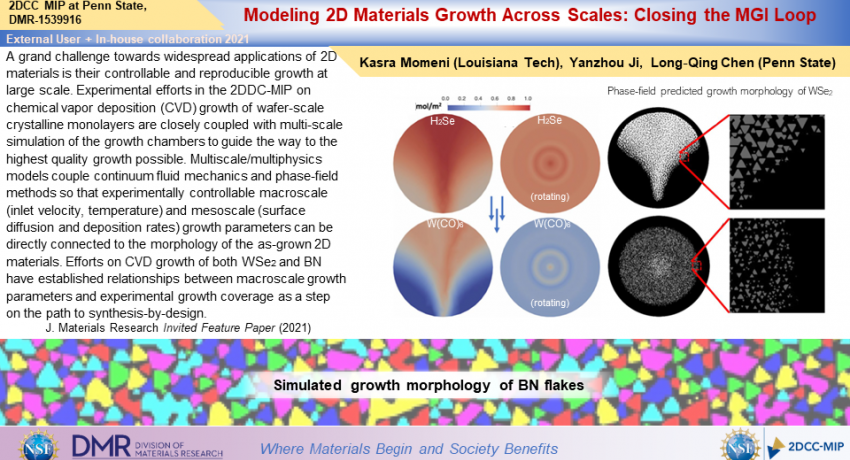What Has Been Achieved:
Multiscale/multiphysics models that couple continuum fluid mechanics and phase-field methods provide a means to map out how experimentally controllable macroscale (inlet velocity, temperature) and mesoscale (surface diffusion and deposition rates) parameters control the morphology of 2D materials, within the precise experimental growth geometries of the 2DCC, in a manner that can then facilitate the transfer of these techniques to other chambers, in the longer term.
Importance of the Achievement:
By unraveling how growth conditions effect outcomes on the microscopic level, the 2DCC can not only produce world-leading quality and scale, but also better understand how to transfer these advances in growth to other groups across the country.
Unique Feature(s) of the MIP that Enabled this Achievement:
Very close iterative interplay of theory and experiment in the MGI model, including in-house researchers (both theory and experiment), 2DCC users, and data curation tools made possible by sustained platform-level investments that enable advances in modeling and growth to be more effectively documented and disseminated in the longer term.
Publications:
2D Materials, 8 (2021) 035033; 10.1088/2053-1583/abfcaa
J. Materials Research Invited Feature Paper (2021); 10.1557/s43578-021-00384-2
Acknowledgements:
Theory and computation for the project was supported by the 2D Crystal Consortium NSF Materials Innovation Platform under cooperative agreement DMR-1539916 with additional support from I/UCRC Center for Atomically Thin Multifunctional Coatings (ATOMIC) seed project SP001-17. Calculations were performed using Louisiana Optical Network Initiative (LONI), the Institute for Computational and Data Sciences Advanced CyberInfrastructure (ICDS-ACI) at Penn State, and the Extreme Science and Engineering Discovery Environment (XSEDE), which National Science Foundation supports with Grant Number ACI-1548562. K. Momeni also acknowledges support from DoE-ARPA-E OPEN (DE-AR0001066), NASA-EPSCoR, the University of Alabama, and NSF-CAREER under CBET-2042683.
Credits/Names: Kasra Momeni (Louisiana Tech), Yanzhou Ji, Long‐Qing Chen (Penn State)
Download PDF Version: 1539916_2DCCMIP_2021_MultiscaleGrowthSimulation.pdf
Year of Research Highlight: 2021
Select a Highlight Type: User Highlight
